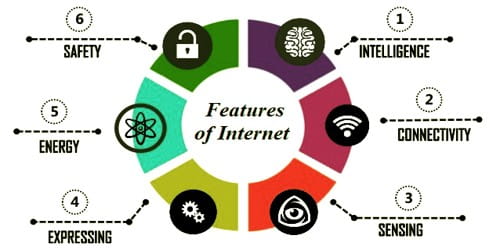Features of the Internet– A vast global network of computers makes up the Internet. It is one of the most powerful communications technologies and connectivity of little extensive networks. Let’s examine the Internet and its characteristics in more depth.
The Internet is a system that connects different networks and computer systems all around the world. Internet usage is widespread and has become an integral part of daily life. Today, life would be incomplete without the Internet. The Internet not only gives consumers immediate access to a vast collection of tools and data but also facilitates finding the information needed to complete various jobs. Additionally, it employees in business and other tasks.

What is the Internet?
The more extensive network enables communication between computer networks operated by businesses, governments, universities, and other organisations worldwide. As a result, we can define the Internet as a system of globally connected computers that communicate and share information using a standardised Internet Protocol.
The World Wide Web (WWW), which consists of interconnected hypertext pages and applications, as well as electronic mail, phone service, and file sharing, are just a few of the many information resources and services available on the Internet. In addition, a wide variety of informational tools and services, including electronic mail, technology, and the World Wide Web, are available through the Internet. TCP/IP, HTTP, and other standard Internet protocols are employed.
Internet: Origin and Development
The first computer networks, such as SABRE (an airline reservation system) and AUTODIN I (a defence command-and-control system), were specialised systems explicitly created for those purposes and put into operation in the late 1950s and early 1960s.
The early 1960s saw the introduction of semiconductor technology into devices made by computer manufacturers. And with traditional batch-processing and time-sharing systems installed in numerous major, technologically advanced businesses. Although several users could access the system “simultaneously,” the time-sharing feature made it possible to share resources of a computer fast with many of them, cycling through a queue of users quickly. As a result, the computer focused on each user’s activities. Sharing computer resources over a whole network was the result of this.
- It made the first host-host network connection on October 29, 1969. The US Department of Defense’s Advanced Research Projects Agency (ARPA) created it.
- Additionally, tools and programmes like SMTP (Simple Mail Transfer Protocol) and FTP appeared (File Transfer Protocol).
- ARPANET also made use of new technology, specifically packet switching. As a result, it cuts down lengthy texts into more manageable chunks.
- Established commercial packet networks in the 1970s to efficiently connect dedicated terminals to remote computers.
- Over packet networks, less expensive “virtual” circuits have taken the place of long-distance modem connections.
- DARPA (Defense Advanced Research Projects Agency), originally known as ARPA, supported initiatives for satellite- and ground-based packet networks. As a result, the development of packet radio has made it possible or even simple to link a mobile terminal to a computer network.
Features of Internet
Significant features of the Internet list below:

Easy to Use
The software or web browser accesses the Internet so that it is relatively basic and can be quickly learnt and used. Therefore, it can also develop quickly.
Flexibility
flexibility in the data transfer process. Essentially, the internet network carries information in digital rather than voice notification in analogue form.
Accessibility
Internet connectivity is available to everyone worldwide. Anyone in the interior can access the Internet, regardless of location. As a result, information transmitted via the Internet consistently travels between networks.
Interaction with Media and Communication Flexibility
The Internet is aiding in business growth. Because of internet service, there is a high level of media contact. For example, news outlets, publications, publishing firms, etc., have expanded their company through Internet service. Additionally, communication is flexible because of internet service. For example, video persons may easily converse with each other using text and voice.
Low cost and security
Internet service has relatively cheap maintenance and development costs. Additionally, on a local and a global level, Internet service improved the security system—for instance, CCTV cameras, etc.
World Wide Web applications
It is an Internet component and allows hypertext documents, enabling users to read and explore different kinds of data. Hypertext markup language (HTML) tags usage to encode documents to create web pages. Each webpage on the Internet has a URL or address (Uniform Resource Locator).
electronic mail (email)
Email is among the most common uses of the Internet. However, people also require an email programme, a domain-named account, and an internet mail server to create, send, and receive emails.
File Transfer Protocol (FTP)
One uses an online program to copy files from one computer to another. For example, a user can connect to an ETP host computer via the Internet and copy files. In addition, it helps locate and copy software files, documents, and other kinds of data.
Telnet
It is a specialised service that enables one person to use a computer to access the data on another computer, a telnet host. Libraries mostly use it to allow patrons to conduct information searches, find articles, etc.
IRC stands for Internet Relay Chat (Real-time video chatting)
This service enables users to converse in real time by entering text in a specific window.
Conclusion:
Throughout its existence, the Features of the Internet has gotten bigger and more complex. To prepare for a significant future expansion in the number of IP addresses accessible, IPv6 create. In a similar trend, the Internet of Things (IoT) refers to the emerging environment where can give nearly any entity or device has a unique identifier (UID) and the ability to communicate data automatically over the Internet.
Also read: What is Internet? Definition, Uses, Advantages and Disadvantages








GIPHY App Key not set. Please check settings